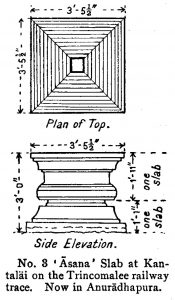OB03085 Kantaläi Gal-Āsana Inscription of Kitti Nissaṅka-Malla
Diagram of the Kantaläi gal-āsana. Published in: Wickremasinghe, Don Martino de Zilva. (1912-27). ‘No. 42. (Reg. No. 3.) Kantaläi Gal-Āsana Inscription of Kitti Nissaṅka-Malla (1187–1196 A.D.),’ Epigraphia Zeylanica 2, p. 283.
IN03105 Kantaläi Gal-Āsana Inscription of Kitti Nissaṅka-Malla
The inscription is engraved around the four sides of a stone seat (gal–āsana), which was discovered in 1921 in the village of Kantaläi on the Trincomalee Railway and afterwards removed to Anurādhapura. The text identifies the stone seat as the one that king Nissaṅka-Malla, after returning from his Indian campaign, used to occupy whilst witnessing the various diversions such as alms-giving, dancing, singing, etc., in the Pārvatī-satra erected at his request in Caturveda-Brahmapura, ‘the city of the Four-Vedic Brahmans’. By way of an introduction, the inscription also includes a bombastic account of Nissaṅka-Malla’s military achievements and charitable acts. Virtually identical accounts are commonly found in other gal-āsana records of this king. The Kantaläi inscription is not dated but, since it references his tours of inspection and his expedition to India, it was probably composed towards the end of his short but eventful reign, which spanned nine years, beginning in 1187 and terminating in 1196. If Kantaläi was the original site of the seat, then this locality must once have been the town called Caturveda-Brahmapura, which was probably occupied mostly by Brahman families for whose benefit an almshouse called Brāhmaṇa-satra was also established by Nissaṅka-Malla.
OB03084 Poḷonnaruva Gal-Vihāra Inscribed Rockface
Gal Vihara, Polonnaruwa. Photograph by John & Co. Published in: The Buddhist Annual of Ceylon, vol. 3, no. 2 (1928), p. 89.
The inscription is engraved on the smoothed area of sloping rock to the right of the cave entrance.
IN03104 Poḷonnaruva Gal-Vihāra Rock Inscription of Parakkama-Bāhu I
The inscription is incised on the sloping granite rockface immediately to the right of the central cave shrine at the rock-cut temple known as Gal-vihāra, which is situated in Polonnaruwa, about one and a half miles north of the Promontory. Famed for its four large rock-relief statues of the Buddha, this temple was originally known as Uttarārāma (North Park). It was built by king Parakkama-Bāhu I, who reigned between 1153 and 1186 A.D. The inscription sets out a code of conduct for the Buddhist clergy. It is divided into two parts, each one terminating in a fish symbol. The first part contains a historical introduction (lines 1–18) and the second part details disciplinary injunctions (lines 18–51).
OB03080 Alutväva Pillar
IN03100 Alutväva Pillar Inscription
The inscription is engraved on three sides of a quadrangular stone pillar found at Alutwväva (Alutwewa, a hamlet near Eppavala), where it was examined by H. C. P. Bell in 1895. The text gives details of a council warrant. Certain portions of the text are no longer legible and, as a consequence, the exact purport of the warrant is unclear. The readable part of the inscription enumerates certain properties in Mahademeṭi-kuḷiya, which are described as being under the management of one Tinḍī Kitu. However, given the damage to the text, it is not possible to say whether the properties were gifted to this man or whether he only received certain privileges in connection with them.
The inscription gives the date upon which the warrant was approved and the date upon which it was proclaimed. Both dates are in the lunar month Und-väp (Nov.-Dec.) in either the fifth or the twentieth (the text is not entirely clear) regnal year of king Siri San̆g-bo. The biruda Siri San̆g-bo was used by several Sri Lankan kings. Dating the inscription on palaeographic grounds to around the tenth century A.D., Wickremasinghe suggests that Siri San̆g-bo refers in this instance to either Sena II (r. 866-901 A.D.) or Kassapa IV (r. 912-929 A.D.), both of whom are known to have used the title. The palaeography more strongly supports the case for Kassapa IV but, of the two, only Sena II ruled for more than twenty years, making him the likelier possibility if the regnal year is interpreted as ‘twentieth’, rather than ‘fifth’.
OB03079 Poḷonnaruva Slab of Sāhasa-Malla
IN03099 Poḷonnaruva Slab Inscription of Sāhasa-Malla
The inscription is incised on both sides of a quadrangular slab, which was discovered sometime before 1874, standing upright at a spot north of the Häṭadāgē in Poḷonnaruva. The text is mostly in Sinhalese but two Sanskrit stanzas in śārdūlavikrīḍita metre make up the first and last five lines; these stanzas are separated from the rest of the text by fish emblems. The inscription gives an account of the parentage and ascent to the throne of Siri San̆gabo Kāliṅga Vijaya-Bāhu, noting that he was the (half-)brother of king Niśśaṅka-Malla and assumed the biruda epithet Sāhaṣa-Malla. It then records that Sāhaṣa-Malla appointed the general Lak-Vijaya-Sin̆gu-Senevi as his prime minister and granted him much wealth.
Whereas most Sri Lankan inscriptions of this period are dated only by the regnal years of ruling monarchs, this record contains a date in the Buddha-varṣa and thus provides a fixed point of historical reference within broader chronologies of the period. The date given in the inscription is 1743 years, 3 months and 27 days of the Buddhavarṣa, Wednesday, the twelfth day of the bright fortnight of the lunar month of Binera (Bhādrapada, Aug.-Sept.). Following Fleet (1909: 331), Wickremasinghe identified this date with Wednesday 23 August 1200 A.D. It refers to Sāhasa-Malla’s anointment as king and not the incision of the inscription. However, the grant recorded in the inscription is described as having taken place in the first year of the king’s reign (between August 1200 and August 1201 A.D.).


